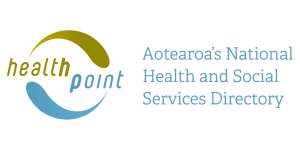Wishing everyone happy holidays and a joyful New Year from the Healthify team. Don't forget to Slip, Slop, Slap and Wrap!
Food groups and serving sizes for adults
Key points about food groups and serving size
- Eating a variety of foods each day helps you to get all the essential nutrients you need to stay healthy and reduces your risk of health conditions such as diabetes and heart disease. It's also important for mental wellbeing.
- A healthy eating pattern includes food from all 4 food groups including vegetables and fruit, grain foods, milk and milk products, and protein foods.
- The recommendations below can guide you on the balance of foods to include in your diet and how much to eat each day.
- You can adapt this information to suit your preferences, food budget and any foods important to your culture.
- This page covers food groups and serving size for adults. There is also a page on food groups and serving size for children.
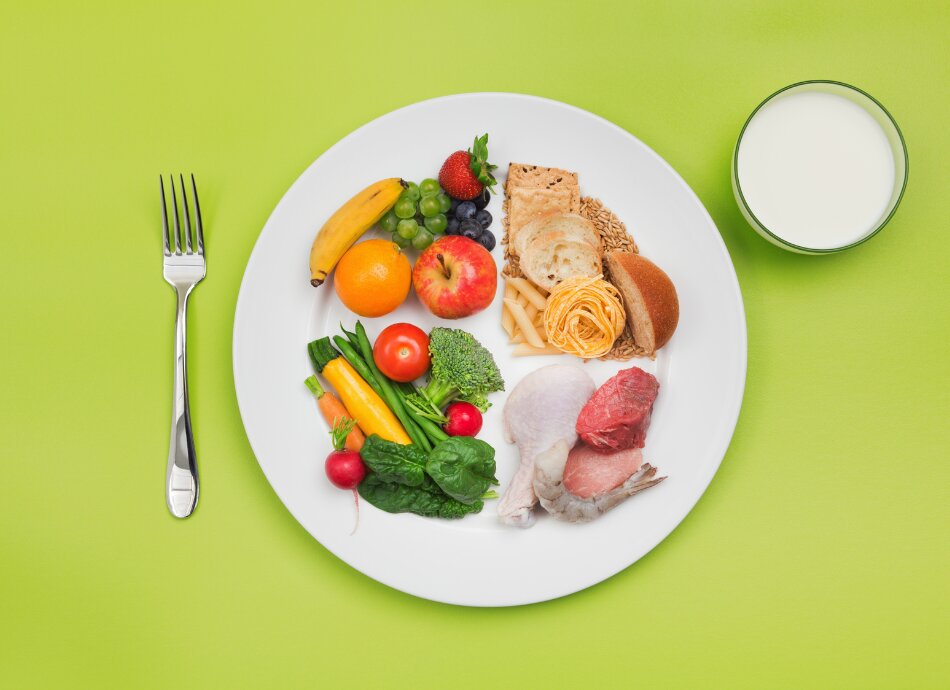
Eating a healthy diet is essential for your overall health and wellbeing. A diet based around a variety of foods helps you get all the essential nutrients you need to:
- stay healthy
- maintain a healthy body weight, and
- lower your risk of health conditions such as diabetes, high cholesterol, high blood pressure, heart disease and some cancers.
What you eat affects not only your physical health but your mental health and wellbeing too. Read more about how food affects your mood. Being healthy also means that you are more likely to be around longer for your whānau.
The 4 different food groups are:
- vegetables and fruit
- grain foods, mostly whole grain and those that are naturally high in fibre
- milk and milk products
- legumes, nuts, seeds, fish and other seafood, eggs, poultry and/or red meat with the fat removed.
By eating a variety of foods from each food group, you're more likely to get the essential nutrients you need to stay healthy and lower your risk of health conditions such as diabetes and heart disease.
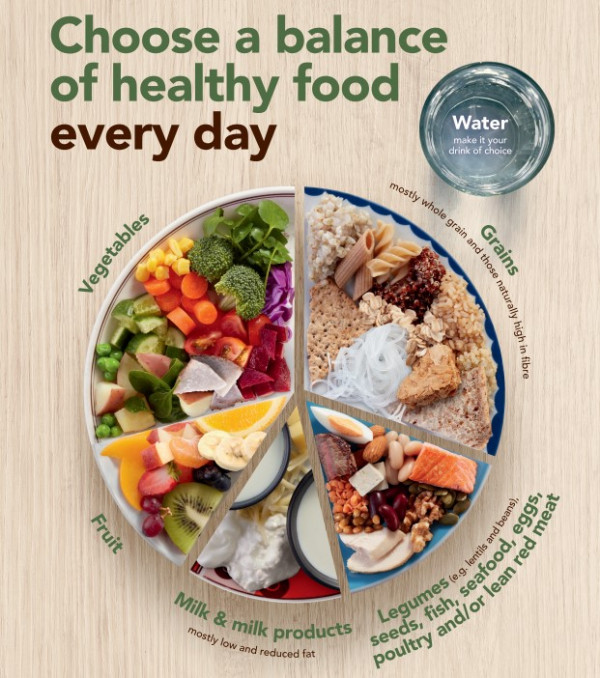
Image credit: Ministry of Health, NZ
Eating a variety of foods each day will help you get all the essential nutrients you need to stay healthy. The number of servings from each food group listed below are for healthy adults, and change based on your age and gender.
Some people who are more active or taller may need additional servings from the 4 food groups. Recommendations also change if you're pregnant or breastfeeding. Read more about eating, drinking and watching your weight during pregnancy.
Food groups and recommended number of daily servings
Vegetables
- At least 5 servings every day.
- Try to include mostly non-starchy vegetables (eg, leafy greens, carrot, broccoli, salad vegetables) on your plate instead of starchy vegetables (eg, potato, kumara, taro, cassava).
Fruit
- At least 2 servings every day.
Grain foods – mostly whole grains and those naturally high in fibre
- 4 to 6 servings per day for most adults. Older women (70+ years) require fewer servings of grain foods (3 servings per day), as they are generally less active and don't use as much energy as younger women.
Legumes, nuts, seeds, fish and other seafood, eggs, poultry and/or red meat with the fat removed
- At least 2 to 3 servings a day for most adults.
Milk and milk products – mostly low and reduced fat
- At least 2.5 servings per day for most adults.
- Women 51 to 70 years of age need more (4 servings a day) to help with bone density and reduce the risk of osteoporosis after menopause.
Included in these recommendations are food sources of healthy fats, which include spreads, vegetable oils, nuts and seeds. The recommendation is for 4 servings per day for men less than 70 years of age and 2 servings per day for women and older men.
This advice is based on the Eating and Activity Guidelines for New Zealand Adults(external link) published by Health New Zealand | Te Whatu Ora.
Use the following information to help serve up different foods on your plate and as a guide for how much to eat each day.
Food group and serving size examples
Vegetables and fruit – includes fresh, frozen and canned
- 1/2 cup of cooked vegetables or 1 cup of salad
- 1/2 a medium sized potato or similar size of kumara, yam or taro
- 1 medium apple, pear, banana or orange
- 1 cup of fresh or stewed fruit salad
Grain foods
- 2 breakfast wheat biscuits
- 1/2 a whole grain bread roll or 1 sandwich slice of whole grain bread
- 1/2 a cup of cooked porridge/rolled oats or 1/4 cup of muesli
- 1/2 cup of cooked pasta or brown rice
Milk and milk products
- 1 glass (250 mL) of milk or calcium-added soy, rice, oat or almond milk
- 1 small pottle of yoghurt
- 2 slices (40 g) of cheese such as edam
Legumes, nuts, seeds, fish, other seafood, eggs, poultry or red meat with fat removed
- 1 cup cooked dried beans, peas or lentils
- A small handful (30 g) of nuts or seeds
- 1 medium piece of cooked fish (100 g)
- 2 eggs
- 80 g cooked chicken
- 65 g of cooked meat (eg, roast lamb, chicken, beef or pork)
This information is a guide only. What's most important is that you listen to your body and tune into when you feel hungry and full. When you eat mindfully, you are less likely to over-eat.
Mindful eating is when you focus on your food rather than being distracted by other things while you're eating.
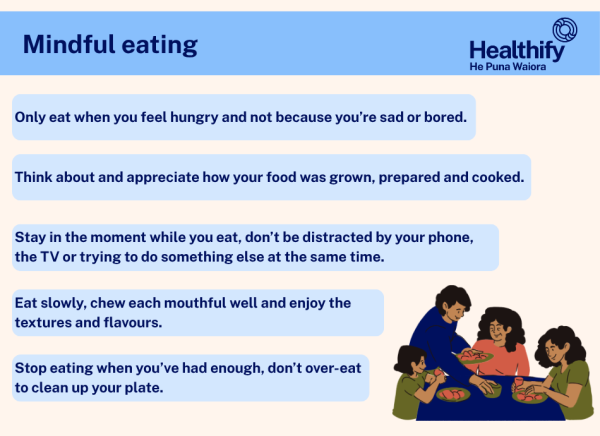
Image credit: Healthify He Puna Waiora
- Base your diet around whole foods from the 4 food groups.
- Include different coloured vegetables and fruit in most meals and as a healthy snack.
- Listen to your body – it's natural to feel hungrier on days you're more active.
- Swap to whole grains and foods high in fibre such as whole grain bread, rolled oats and brown rice.
- Try to include legumes in your meals. These include lentils, split peas, chickpeas and cooked dried beans (eg, red kidney beans).
- Use your hands as a simple guide to know how much food to serve up on your plate.
- Plan your meals ahead of time so that you can eat balanced meals most of the time. When you don’t plan ahead you are more likely to grab something on the go.
- Make plain water your first choice over other drinks.
- If you drink alcohol, it's better to drink less. Avoid alcohol if you're pregnant or breastfeeding.
- Choose and/or prepare foods and drinks:
- with unsaturated fat (eg, canola oil, olive oil) instead of saturated fat (eg, butter, cream, coconut oil)
- that are low in salt (sodium)
- with little or no added sugar
- that are mostly ‘whole’ and less processed.
- Prepare, cook and store food in a way that makes sure it's safe to eat.
Healthy recipes(external link) Healthy Food Guide, NZ
Heart healthy recipes(external link) Heart Foundation, NZ
Brochures
Choose a balance of healthy food every day poster [JPG, 147 KB] Ministry of Health and Health Promotion Agency, NZ, 2020
Healthy eating, active living(external link) HealthEd, NZ, 2024
Eat healthy food and move more every day(external link) HealthEd, NZ, 2024
Eating for healthy older people(external link) HealthEd, NZ, 2024
Food portions(external link) Heart Foundation, NZ
Healthy heart food guide poster(external link) Heart Foundation, NZ
Eating and activity guidelines for New Zealand adults(external link) Health New Zealand | Te Whatu Ora, NZ, 2020
Apps
References
- Eating and activity guidelines for New Zealand adults(external link) Health New Zealand | Te Whatu Ora, NZ, 2020
- New serving size advice(external link) Ministry of Health, NZ, 2020
- Healthy eating, active living(external link) HealthEd, NZ, 2024
Brochures
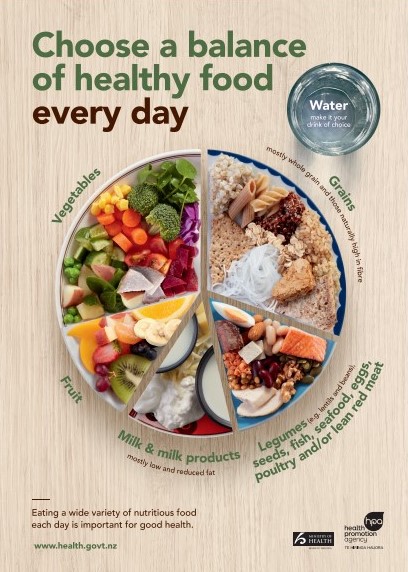

Ministry of Health and Health Promotion Agency, NZ, 2020
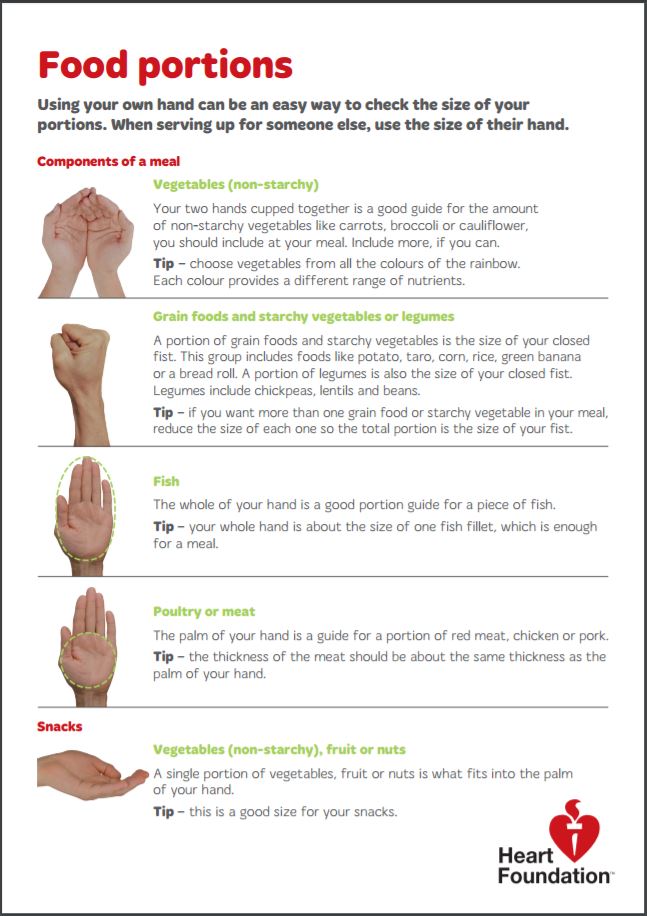
Heart Foundation, NZ

Healthy eating, active living
HealthEd, NZ, 2024
Credits: Healthify editorial team. Healthify is brought to you by Health Navigator Charitable Trust.
Reviewed by: Lily Henderson, Registered Dietitian
Last reviewed:




